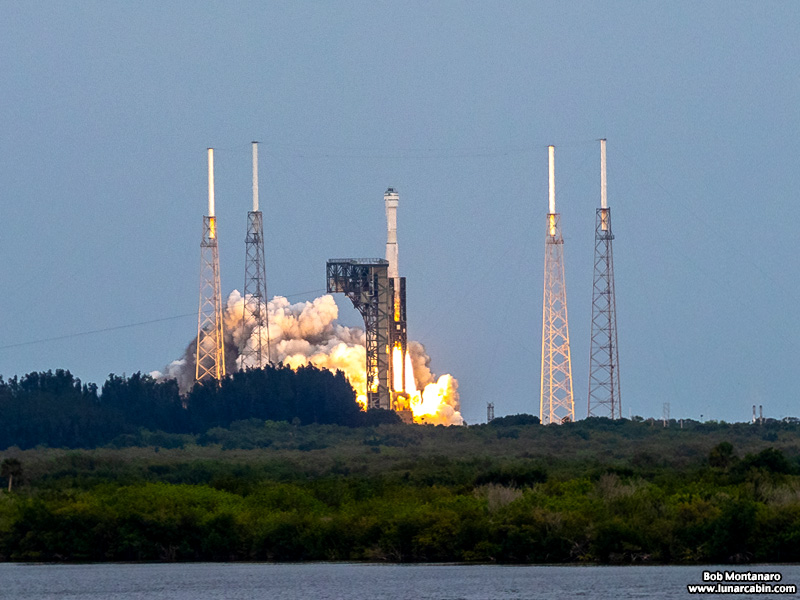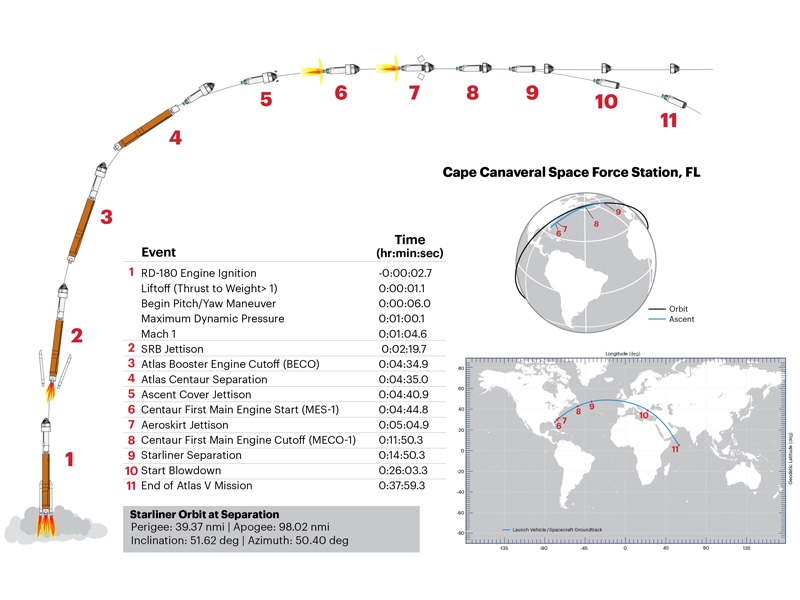 |
|
Starliner OFT-2 (Atlas V) 19 May 2022 |
Space Launch Complex 41 Cape Canaveral Space Force Station |
A United Launch Alliance (ULA) Atlas V rocket launched Boeing's Crew Space Transportation (CST)-100 Starliner spacecraft on its Orbital Flight Test-2 (OFT-2) to the International Space Station at 6:54 p.m. on 19 May 2022 from Space Launch Complex-41 at Cape Canaveral Space Force Station. OFT-2 is the second uncrewed flight of the Starliner that will demonstrate the spacecraft's human transportation capabilities. This test flight is the last major step before the Atlas V and Boeing's Starliner capsule take American astronauts to the International Space Station as part of NASA's Commercial Crew Program. Part of NASA’s Commercial Crew Program (CCP), the uncrewed OFT is the second launch of the CST-100 Starliner. The second uncrewed test flight will demonstrate end-to-end performance of the Atlas V rocket and Starliner spacecraft, including performance of the guidance, navigation and control systems, ground systems and operations teams, as well as on-orbit, docking at the International Space Station (ISS), re-entry and landing operations. For OFT-2, Starliner will spend about five to 10 days in space and deliver more than 500 pounds of NASA cargo to the space station. This includes food and crew preference items for the current expedition crew members on station, and provisions, like clothes and sleeping bags, for CFT astronauts. The spacecraft will return to Earth in the western United States with more than 550 pounds of cargo, including reusable Nitrogen Oxygen Recharge System (NORS) tanks that provide breathable air to station crew members. |
|
 |
|
| Space Launch Complex-41 at Cape Canaveral Space Force Station. The pad is at left surrounded by four white-tipped lightning towers. The rocket was assembled vertically in the Vertical Integration Facility (VIF) at right and transported by rail to the pad. | |
 |
|
Gaseous oxygen is seen being vented as the Atlas V rocket is fueled. |
|
 |
|
 |
|
 |
|
 |
|
 |
|
 |
|
 |
|
 |
|
 |
|
 |
|
 |
|
 |
|
 |
|
The image below and all subsequent images were taken through a light, cloudy haze that the rocket passed through and above. |
|
 |
|
 |
|
 |
|
Burnout and separation of the two Solid Rocket Boosters. |
|
 |
|
| The Atlas V carries Starliner into orbit as seen at lower left while one of the Solid Rocket Boosters can be seen trailing behind on its long fall to the Atlantic Ocean below. | |
ABOUT STARLINER AND THE ATLAS V ROCKET |
|
 |
|
IMAGE: NASA |
|
 |
|
ATLAS V LAUNCH VEHICLE [TEXT & IMAGE: UNITED LAUNCH ALLIANCE] The CST-100 Starliner is attached to the Atlas V using a launch vehicle adapter (LVA), which also includes an aeroskirt to reduce the aerodynamic loads on the vehicle. The aeroskirt is jettisoned for improved performance following booster stage separation. Centaur Booster |
|
 |
|
OFT-2 launch profile. IMAGE & TEXT: UNITED LAUNCH ALLIANCE |
|
 |
|
Starliner Facts. IMAGE: BOEING |
|
 |
|
IMAGE: Boeing & NASA |
|
All contents copyright Lunar Cabin |
|